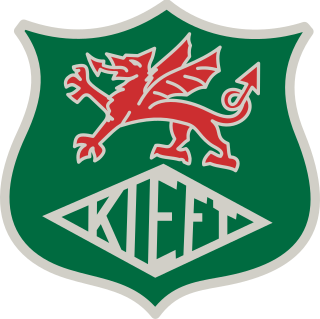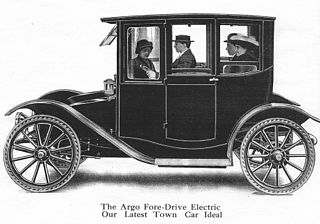Related Research Articles
The Alesbury was an Irish automobile. It was powered by an 8/10 hp Stevens-Duryea engine and had solid tires. The car was exhibited in Dublin in 1907, and manufacture lasted from then until 1908.

The Argo was a short-lived American automobile manufactured by the Argo Motor Co in Jackson, Michigan, between 1914 and 1918. Previously, the factory had been used by the Standard Electric Car Co to build an electric car.

The Arnold was one of the first motor cars manufactured in the United Kingdom. It was produced in East Peckham, Kent between 1896 and 1898.

The Benz Velo was one of the first cars, introduced by Carl Benz in 1894 as the followup to the Patent-Motorwagen. 67 Benz Velos were built in 1894 and 134 in 1895. The early Velo had a 1L 1.5-metric-horsepower engine, and later a 3-metric-horsepower engine giving a top speed of 19 km/h (12 mph). The Velo was officially introduced by Karl Benz as the Velocipede, and became the world's first standardized serial production car. The Velocipede remained in production between 1894 and 1902, with a final count of over 1,200 produced.

A de Dion axle is a form of non-independent automobile suspension. It is a considerable improvement over the swing axle, Hotchkiss drive, or live axle. Because it plays no part in transmitting power to the drive wheels, it is sometimes called a "dead axle".

The Daihatsu Bee is a three-wheeled microcar produced by the Japanese automobile manufacturer Daihatsu from 1951 until 1952.

Felice Nazzaro was an Italian racecar driver, a native of Turin. He won the Kaiserpreis in 1907 as well as the French Grand Prix in 1907 and 1922 and Targa Florio in 1907, and 1913. His European wins in 1907 resulted in an invitation to compete in the 1908 American Grand Prize in Savannah, Georgia, where he finished third. He returned to the United States for the 1910 event but a damaged rear axle forced him out of the race. It was his victory in the 1908 Circuito di Bologna that inspired a young Enzo Ferrari to become a racing driver.

Kieft Cars, founded by Cyril Kieft, was a British car company that built Formula Three racing cars and some road going sports cars in a factory in Derry St, Wolverhampton.
Agricola was a Greek maker of 4x4 multi-purpose trucks and other farm machinery based in Thessaloniki. The Agricola 25 GT 4x4 truck was a fairly advanced design introduced in 1975, with enhanced all-terrain capabilities, a metal cab and Mercedes-Benz 180D Diesel engine. It was a typical Greek multi-purpose truck with a payload of 1,650 kg (3,638 lb) and a maximum speed 80 km/h (50 mph). The cab was designed by Georgios Michael, designer of other Greek vehicles including the Neorion Chicago and the MAVA-Renault Farma. The vehicle was produced until 1984.

The Otomo was a Japanese automobile built by Mr. Hayataya Toyokawa from 1924 to 1927 at the Hakuyosha Ironworks in Tokyo. It was meant to build upon his experimental Ales cars of 1921. Otomo offered an air-cooled 944 cc four-cylinder light car, available as two- or four-seat tourer or saloon (sedan), or as a van. This was joined in 1926 by a water-cooled 24 hp model. During this time, Otomo was one of only two Japanese automakers, joined by the Japanese established Gorham Automobile Company, financed by American aircraft engineer William R. Gorham. The remnants of the Gorham Automobile Company became the Nissan Motor Company Ltd. The car found it difficult to compete with Ford Model T's being manufactured at Yokohama, and Chevrolet Capitols being built at Osaka, and the company was integrated with other smaller Japanese automobile manufacturers. The 1923 Great Kantō earthquake also disrupted the local economy, with manufacturing resources greatly affecting business operations.

The Argo Electric Vehicle Company was an American electric automobile manufacturer that operated in Saginaw, Michigan, from 1912 to 1916. The Argo Electric used a 60 volt system with Westinghouse motors. They claimed to be capable of 20 mph (32 km/h). It had 6 forward and 6 reverse speeds, had 36 x 4 cushion tires and used an 18-inch (457 mm) steering wheel on the left. They were offered in both four- and five-passenger models, with open and closed versions available, and all models used steering wheels. The 110-inch (2,794 mm) wheelbase was the longest of any electric at the time. The Argo Brougham was a 4-passenger car, weighing 3,200 lb (1,451 kg), claimed a range of 75 miles (121 km) per charge using thirty 190 ah, MV Exide batteries.
The Aérocarène 700 was a small automobile developed in France and first exhibited at the Paris Motor Show at the end of October 1947.
The Albany was a British car made in London from 1903 to 1905. Albany Manufacturing Co. Ltd made both petrol and steam cars, the steamers designed by Frederick Lamplough, who had originally built a shaft-driven steamer in 1896. Better known as the Lamplough-Albany, it sported two engines coupled by cranks at right angles and a super-heated coil-type generator. It could be steered either by wheel or tiller, and it appeared much like a petroleum-fueled car. It was offered for a single model year, 1903, while the petrol vehicles, one a 10 hp (7.5 kW) single-cylinder and the other a 16 hp 2-cylinder, lasted for three. After the middle of 1905, Albany shifted its attention to selling Talbots and manufacturing parts.
The American Junior was made by American Motor Vehicle Company of Lafayette, Indiana from 1916 to 1920. Also known simply as the American, it was an ultra-light two-seat vehicle with a one-cylinder engine. It was mainly intended to be sold for children. Its manufacturers hoped to compete with rickshaws in China and to produce electric vehicles for invalids.

The American Mercedes was made by Daimler Manufacturing Company of Long Island City, New York, United States from 1904 to 1907. They were licensed copies of German Mercedes models. Some commercial vehicles, such as ambulances, were also made. The company was in direct competition with Mercedes Import Co. of New York, which handled the imported Mercedes for the entirety of the United States, at least in 1906.
Edward Butler (1862–1940) was an English inventor who produced an early three-wheeled petrol automobile called the Butler Petrol Cycle, which is accepted by many as the first British car.

The Cudell was a Prussian-German car made from 1898 to 1908. It was made in Aachen until 1905, and subsequently in Berlin.

Georges Tradée Bouton (1847–1938) was a French toymaker and engineer who with fellow Frenchman Jules-Albert de Dion founded the De Dion-Bouton company in 1883. The pair first worked together in 1882 to produce a self-propelled steam vehicle. The result gave birth to the company which, at the time, went under the name Trépardoux et Cie.

Ohta Jidosha was one of the largest Japanese automotive manufacturing companies in the 1930s. The company was established in 1922, and produced cars from 1934 until 1957, when it was acquired by Tokyu Kurogane Kogyo company and ceased auto production. The factory became Omori Works when it became part of Nissan when Kurogane joined the corporate structure.
Fabbrica Ligure Automobili Genova, F.L.A.G., FLAG, was an Italian automobile manufacturer founded in 1905 by investors in La Spezia, Liguria, that produced large, prestigious, luxury vehicles. Shortly after founding it transferred to Genoa and then in 1909 it merged with Società Piemontese Automobili (S.P.A.) in Turin.
References
- Georgano, G.N., "Alexandra", in G.N. Georgano, ed., The Complete Encyclopedia of Motorcars 1885-1968 (New York: E.P. Dutton and Co., 1974), pp. 33.